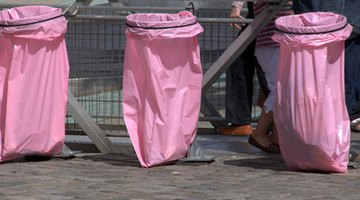What are Trash Bags Made Of?
Table of Contents
Three Canadians--Harry Wasylyk, Frank Plomp and Larry Hansen--made the first trash bags in 1950. CBC television ranked their invention 36th among 50 top Canadian inventions. Initially trash bags were called "green garbage bags" because of their color.

These bags were first launched for commercial use, but beginning in 1960 they were made for home use as well.
Function
Trash bags, or garbage bags, have become very popular, owing to their capacity to hold garbage securely without leakage or spillover. The odor of the waste material is minimized when it is packed in trash bags. These bags come in various sizes to hold various amounts of garbage. They can hold all sorts of litter or food waste without creating a mess.
Raw Materials
Polyethylene plastic is the most common material used to manufacture trash bags. Polyethylene was invented in 1942 in the form of small beads. The process of extrusion then transformed these plastic beads into plastic bags. Trash bags are made from low-density polyethylene (LDPE), which is purported to be flexible, soft, airtight and waterproof. At times, to provide strength to the bags, high-density polyethylene (HDPE) is also used.
Manufacturing
There are several steps to change polyethylene beads into plastic bags:
1) Polyethylene beads are heated to 200 degrees C. 2) High pressure is applied to the molten polyethylene beads to make the plastic flexible. 3) Color is added to make the plastic attractive. 4) Colored plastic is converted into a large roll of bags. 5) The last step involves cooling down the bags to be cut and collapsed into various shapes. Finally a seal is put on them.
Biodegradable Trash Bags
Trash bags made of plastic are not very eco-friendly, as they take years to decompose. To address the problem, Canadian chemist Dr. James Guillet invented biodegradable plastic in 1971. These plastics are remarkable, as they can decompose when exposed to sunlight, air and moisture. Another kind of trash bag now being used is the oxo-biodegradable trash bag. These bags decompose in low temperatures and, once degraded, are normal waste and do not contaminate the soil. So, these are safer to use and have overcome the limitations of earlier versions of plastic trash bags, which could not be readily disposed by processes of photo-oxidation and thermo-oxidation.
Variety
Some expensive trash bags have two linings to make them completely impervious. These bags have an outer waterproof plastic bag with an inner lining consisting of a sheet of cellulose fluff pulp. These bags are used for trash with high water content and bad odor. Some trash bags come with draw strings or wire twist ties to tightly secure the garbage inside the bag. Plastic trash bags are highly durable and sanitary.
The Drip Cap
- Three Canadians--Harry Wasylyk, Frank Plomp and Larry Hansen--made the first trash bags in 1950.
- Trash bags are made from low-density polyethylene (LDPE), which is purported to be flexible, soft, airtight and waterproof.
- 5) The last step involves cooling down the bags to be cut and collapsed into various shapes.
- To address the problem, Canadian chemist Dr.
- James Guillet invented biodegradable plastic in 1971.
- These bags are used for trash with high water content and bad odor.
- Some trash bags come with draw strings or wire twist ties to tightly secure the garbage inside the bag.
Writer Bio
Eric Bagai is a senior writer in the high-technology field, to which he can offer more than seven years of experience as a copywriter. He has written several articles for eHow and holds a Master of Arts in creative writing from Oregon State University.
Photo Credits
- poubelles roses image by Bruno Bernier from Fotolia.com
- poubelles roses image by Bruno Bernier from Fotolia.com
More Articles



